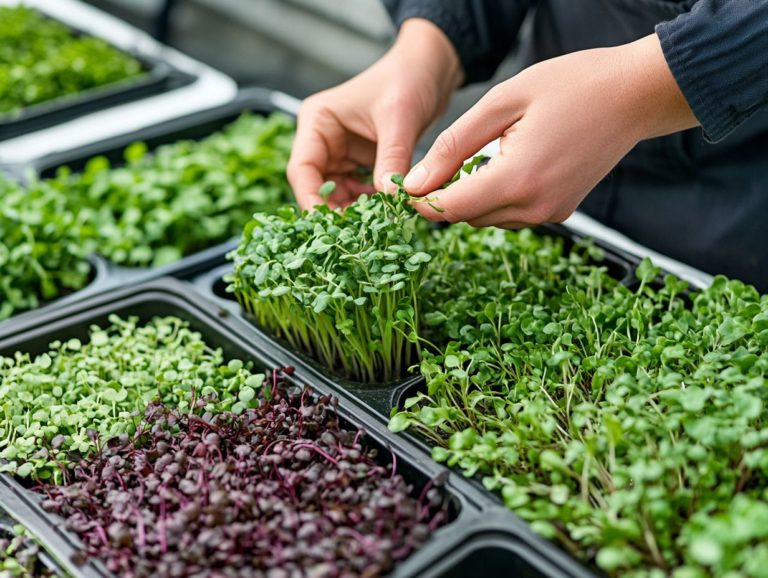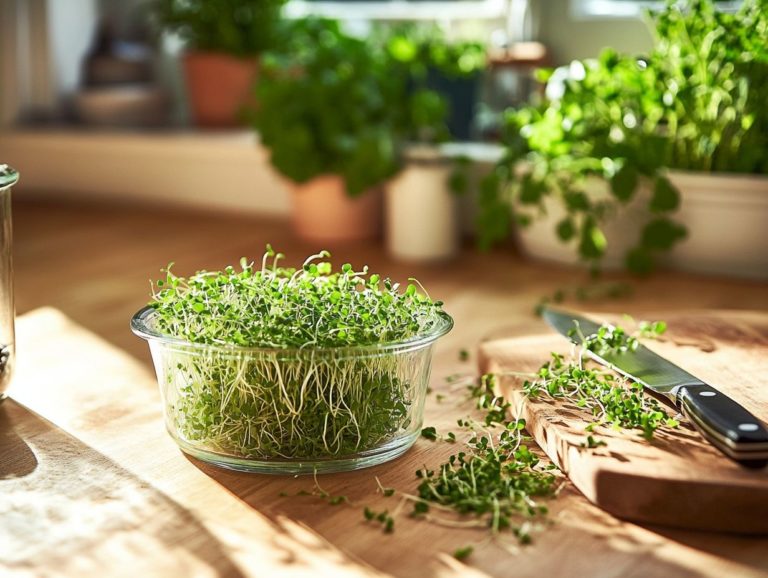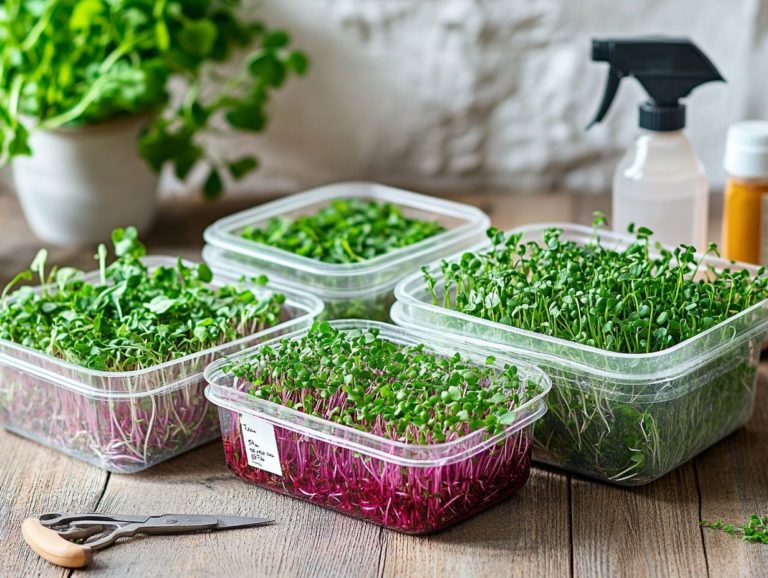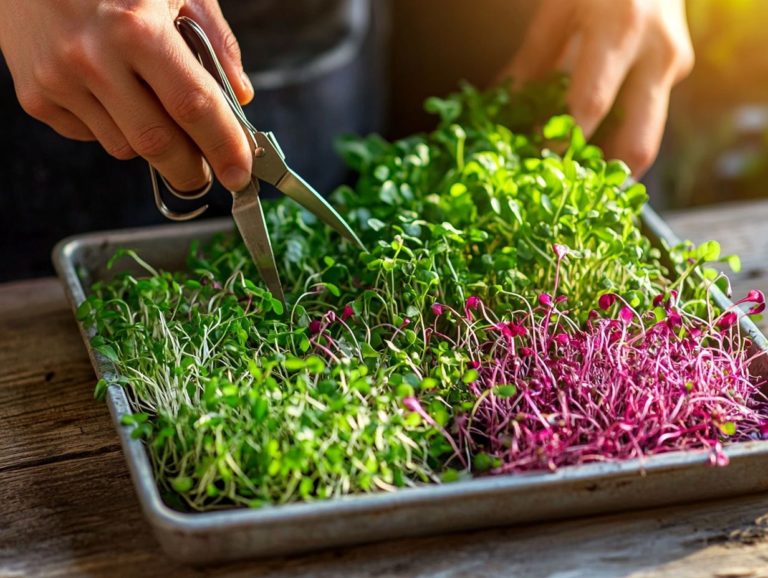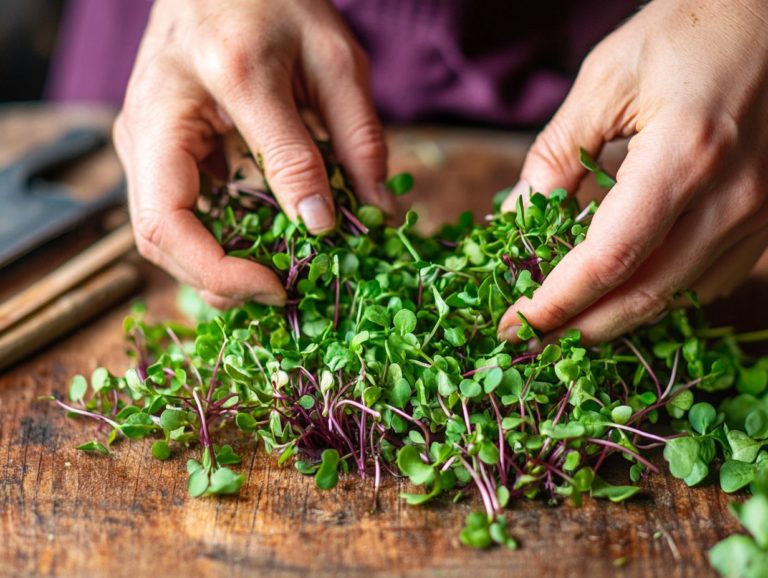How to Prevent Spoilage in Microgreens
Want to enjoy fresh, flavorful microgreens in your dishes? Read on to master the art of keeping them vibrant!
Microgreens have emerged as a sought-after ingredient in the culinary realm, bringing vibrant flavors and a remarkable nutritional boost with each petite leaf.
However, their delicate nature renders them vulnerable to spoilage. It s essential to understand what microgreens are, the factors that contribute to their deterioration, and how to recognize the signs of spoilage if you wish to relish their freshness fully.
This article delves into effective strategies for prevention, covering everything from proper harvesting techniques to optimal storage methods, ensuring your microgreens remain crisp and flavorful for an extended period.
Contents
- Key Takeaways:
- Understanding Microgreens
- Causes of Spoilage in Microgreens
- Signs of Spoilage in Microgreens
- Preventing Spoilage in Microgreens
- Tips for Maintaining Freshness in Microgreens
- Frequently Asked Questions
- What is the best way to prevent spoilage in microgreens?
- How can I tell if my microgreens are spoiled?
- Should I wash my microgreens before storing them?
- Can I freeze microgreens to prevent spoilage?
- What are some common causes of spoilage in microgreens?
- Are there any natural methods to prevent spoilage in microgreens?
Key Takeaways:
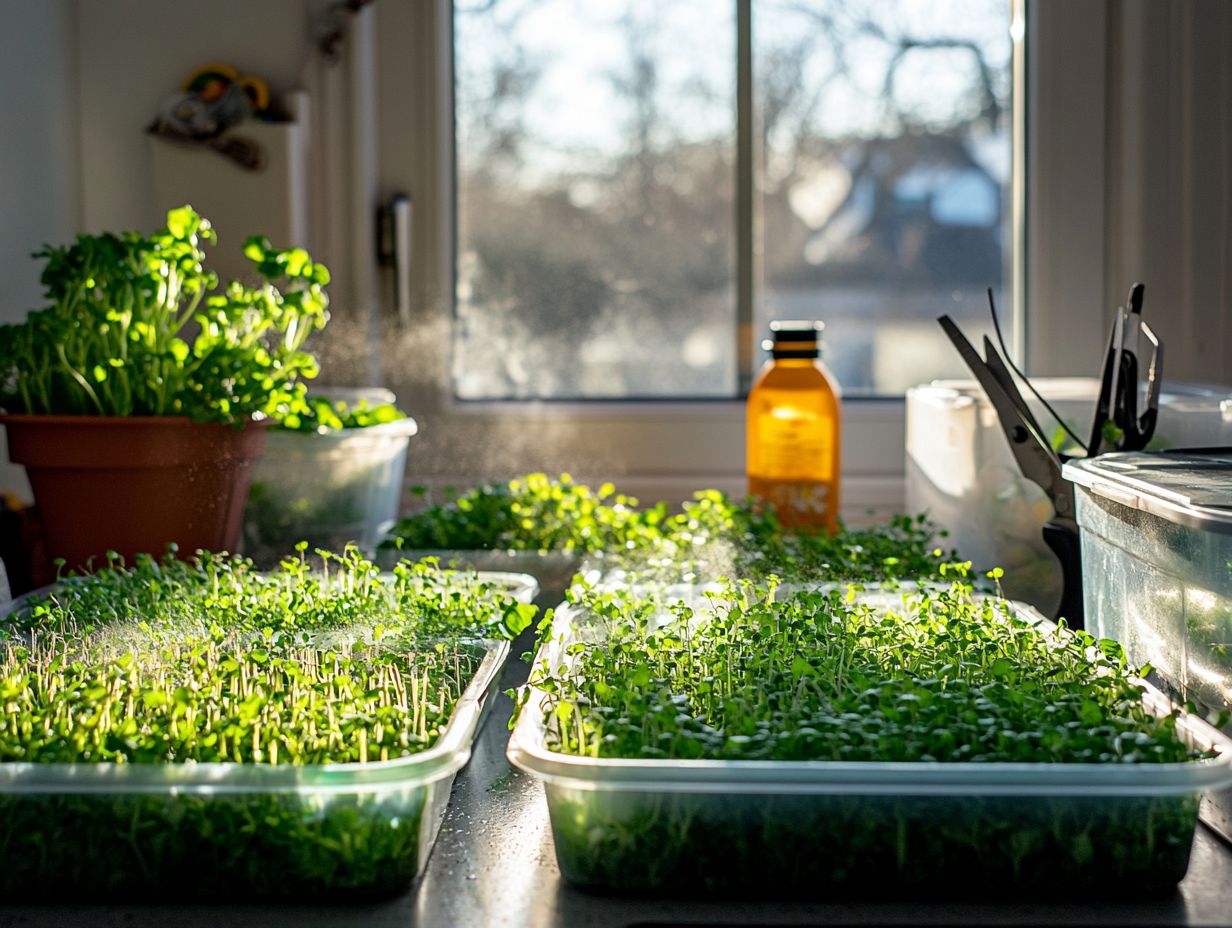
- Keep your microgreens fresh with these essential tips!
- Proper harvesting techniques and storage methods are crucial in preventing spoilage.
- Sanitation practices and avoiding contamination are key to maintaining freshness.
- Using preservatives and paying attention to visual cues and taste can help identify signs of spoilage.
Understanding Microgreens
Let s dive into what microgreens are all about! Microgreens are young plants harvested just after the seed leaves emerge, packed with an impressive concentration of vitamins and minerals.
Often hailed as a superfood, you ll find that they can be easily grown at home, making them a perfect choice for anyone passionate about sustainable gardening.
With their enticing flavors and textures, microgreens have become a staple in gourmet cooking. To truly enjoy their benefits, it’s essential to store them properly, ensuring you maintain their freshness and extend their shelf life.
What are Microgreens?
Microgreens are those delightful, tiny edible plants you harvest just after their seed leaves have developed. They come in a stunning array of flavors and colors, including broccoli, kale, mustard, radish, and sunflower shoots.
These colorful greens grow in just a week or two, transforming from humble seeds to nutrient-dense leaves rich in vitamins and antioxidants. As they grow, each type reveals its distinct flavor profile think the peppery bite of arugula or the sweet, nutty taste of sunflower.
Not only do they bring a burst of color to your salads and sandwiches, but they also serve as exquisite garnishes for soups and entrees, enhancing both the visual appeal and the taste of your dishes.
Packed with essential vitamins like C, E, and K, alongside vital minerals, microgreens can elevate the nutritional content of your meals while complementing various culinary styles, making them a go-to choice for health-conscious cooks.
Causes of Spoilage in Microgreens
The spoilage of microgreens can be traced to several factors, including environmental influences like temperature variations, humidity levels, and potential contamination. These issues can result in mold growth and a decline in quality.
Grasping these causes is crucial for anyone aiming to elevate the care of microgreens and maintain the nutritional value of these delicate greens, as well as prevent mold. For those facing challenges, referring to troubleshooting common microgreen growth issues can provide valuable insights.
Environmental Factors
Environmental factors are pivotal in determining the shelf life and quality of microgreens. They influence critical aspects such as moisture levels, humidity, temperature control, and the movement of air around the plants all of which can lead to spoilage if not managed meticulously.
Grasping how these elements interact is essential for anyone aspiring to cultivate microgreens effectively. For example, maintaining optimal humidity levels can prevent mold growth, while ensuring adequate moisture keeps those delicate greens from wilting.
Temperature optimization is important because microgreens thrive in a range between 60 F and 70 F. Proper air flow around the plants enhances nutrient absorption and reduces the risk of spoilage caused by stagnant air.
Regularly checking for signs of spoilage, such as discoloration or an unpleasant odor, allows you to implement timely storage solutions that preserve freshness.
Contamination
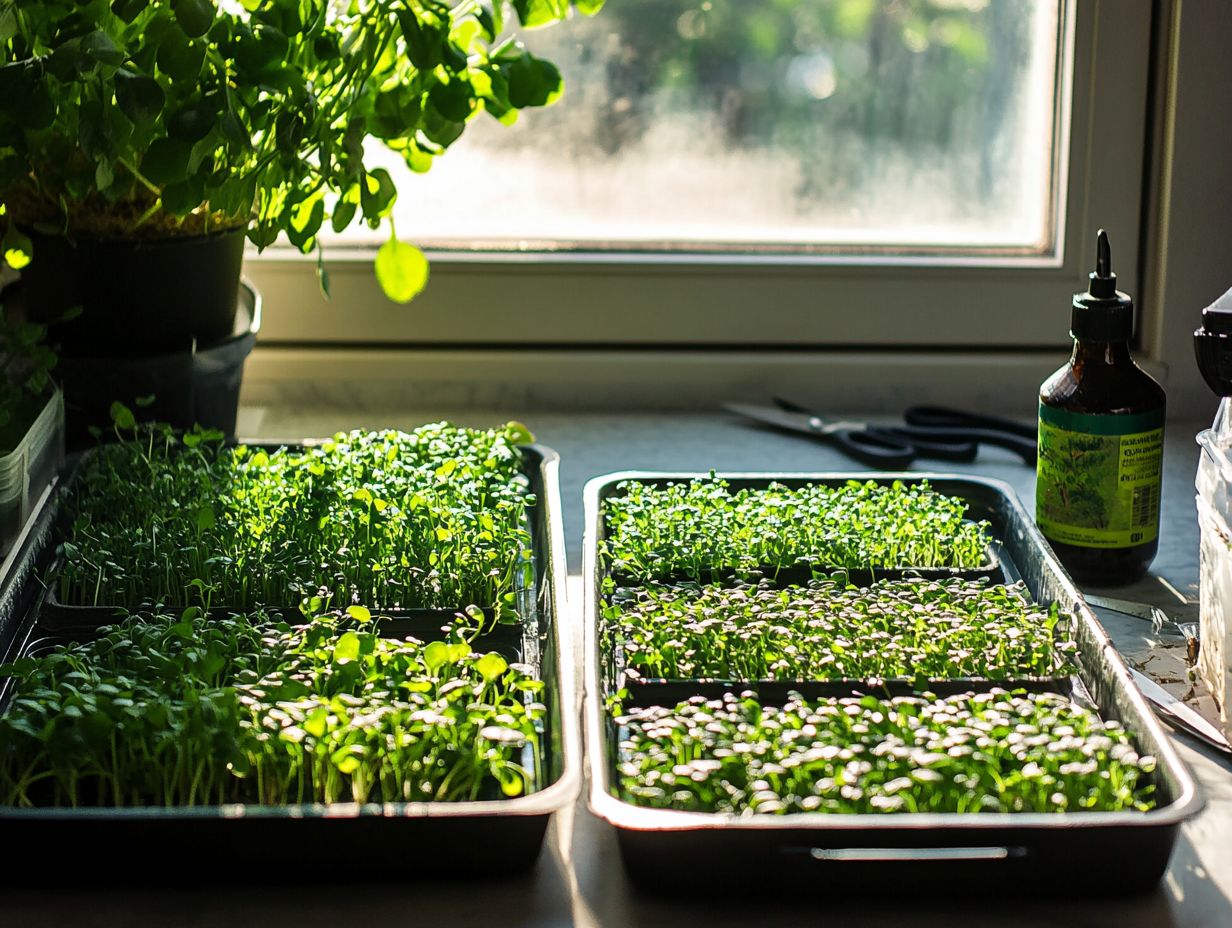
Microgreens can get contaminated through dirty tools, mishandling, and exposure to ethylene. This shows why hygiene is so important.
Establishing a rigorous sanitation regimen is essential to mitigate these risks. Make it a habit to disinfect your tools and surfaces regularly to reduce the chances of harmful microorganisms taking hold. Additionally, implementing watering techniques for thriving microgreens can further enhance their health. By following proper handling techniques like washing your hands and using gloves, you can further protect your microgreens.
Remember, ethylene, often emitted by ripening fruits and vegetables, can lead to premature spoilage. It s vital to store your microgreens away from these ethylene-producing sources.
Implement systematic routine checks to catch any signs of contamination early. This allows for timely intervention and effective spoilage detection. This way, you can maintain the freshness and quality that your consumers expect and deserve.
Signs of Spoilage in Microgreens
Detecting spoilage in microgreens is essential for preserving their freshness and quality. Look for visual cues like discoloration or wilting, as well as changes in smell and taste.
These indicators often signal a decline in flavor retention and nutrient value, making it crucial to stay vigilant.
Visual Cues
Look for visual cues to spot spoilage in microgreens. Signs such as discoloration, wilting, or the presence of mold should raise immediate red flags.
When inspecting microgreens, closely observe their vibrancy. Lively greens are the hallmark of freshness, while dull or yellowish hues often signal that the product is on the decline.
Don t underestimate the importance of a tactile assessment healthy greens should feel firm and crisp in your hands. If they are limp or overly soft, this can indicate dehydration or decay. Maintaining proper moisture balance is key.
If you catch any unpleasant odors, consider it a serious warning sign of degradation. If you notice any spoilage indicators, swift action is crucial.
Make sure to discard any affected microgreens to avoid potential health risks. Ensure that you re only enjoying fresh, nutritious options.
Smell and Taste
Watch for changes in smell and taste; they signal spoilage. If you notice off-odors or a dull flavor, it s a clear sign that freshness and nutritional value are on the decline.
The sensory profiles of these vibrant plants play a significant role in their appeal. When spoilage sets in, not only do those lively flavors fade, but the nutritional benefits also take a hit, resulting in a less enriching experience overall.
The complex flavors that make microgreens so enticing are linked to their natural chemicals that affect flavor. These can shift dramatically as they age. This transformation can significantly affect flavor retention. It’s essential for you, whether as a consumer or producer, to stay alert to these sensory changes. Additionally, understanding how to rotate crops for microgreens can help maintain those vibrant flavors.
Preventing Spoilage in Microgreens
Preventing spoilage in microgreens demands a comprehensive strategy. Focus on mastering proper harvesting techniques, including cutting microgreens, implementing effective storage and handling methods, and adhering to stringent sanitation practices.
This trifecta not only preserves their quality but also extends their shelf life, ensuring that you enjoy the freshest microgreens possible.
Proper Harvesting Techniques

Proper harvesting techniques are vital for maintaining the quality of your microgreens. Using a sharp knife and handling the greens gently during cutting reduces the chances of bruising and spoilage.
This careful approach enhances the visual appeal of your greens and maximizes their nutritional value. This way, your consumers receive the best possible product.
Choosing the right tools is crucial; a clean, sharp knife should be your top choice. Dull blades can crush the stems and lead to uneven cuts.
Precision trimming techniques also promote better soil health, paving the way for robust growth of subsequent crops.
It s important to keep your hands and tools clean to protect against potential contaminants that could compromise the integrity of your microgreens.
Storage and Handling
Storing microgreens properly is essential for maximizing their shelf life. Choosing the right container, maintaining optimal moisture levels, and ensuring proper drainage can significantly enhance their freshness.
When selecting a container, consider the pros and cons of plastic versus paper towel options. Plastic containers retain moisture well but require vigilance to prevent excessive humidity, which can lead to spoilage. On the other hand, paper towel wraps excel in moisture control; they absorb excess water while allowing for sufficient airflow.
Regularly check for condensation inside the container, as this can create a damp environment that jeopardizes the health of your microgreens.
By skillfully managing these elements, you can enjoy vibrant, nutrient-rich greens for an extended period.
Sanitation Practices
Using strict sanitation practices is your best defense against contamination and mold growth in your microgreens. Ensuring all tools and surfaces are impeccably clean before handling these delicate plants is key to success.
To achieve this, regularly disinfect pots, trays, and any implements that contact your plants. A mix of bleach and water can effectively eliminate harmful bacteria and spores. Keeping a clean workspace by wiping down surfaces with sanitizing wipes helps prevent the buildup of pathogens that could harm your microgreens. For those interested in growing microgreens, following a step-by-step guide to sowing microgreens can be beneficial.
Proper sanitation not only extends the shelf life of your greens but also safeguards their quality. This reduces the risk of spoilage and promotes a healthy growing environment. By adopting these practices, you can significantly cut down on mold formation, ensuring your produce remains fresh and vibrant. Avoiding the top 5 mistakes in growing microgreens can help you achieve this goal.
Tips for Maintaining Freshness in Microgreens
Maintaining the freshness of microgreens is crucial for savoring their full nutritional value and flavor. By using effective storage methods and judiciously applying preservatives, you can extend their shelf life and enjoy their vibrant benefits for longer.
Best Storage Methods
The Best Methods for Storing Microgreens involve refrigeration coupled with careful moisture control to prevent spoilage. This ensures they stay fresh and flavorful for an extended period.
Proper refrigeration inhibits the growth of spoilage-causing bacteria and preserves the vibrant colors and delicate textures that make microgreens enticing. To get the best results, consider the perfect light conditions for microgreens and using breathable containers to significantly enhance their shelf life.
Finding that sweet spot is essential; too much moisture invites mold, while too little leads to wilting. Temperature fluctuations can compromise the overall freshness of microgreens, so a consistent, cool environment is necessary to keep them crisp and nutritious.
By embracing these storage techniques, you can savor microgreens at their peak quality.
Using Preservatives
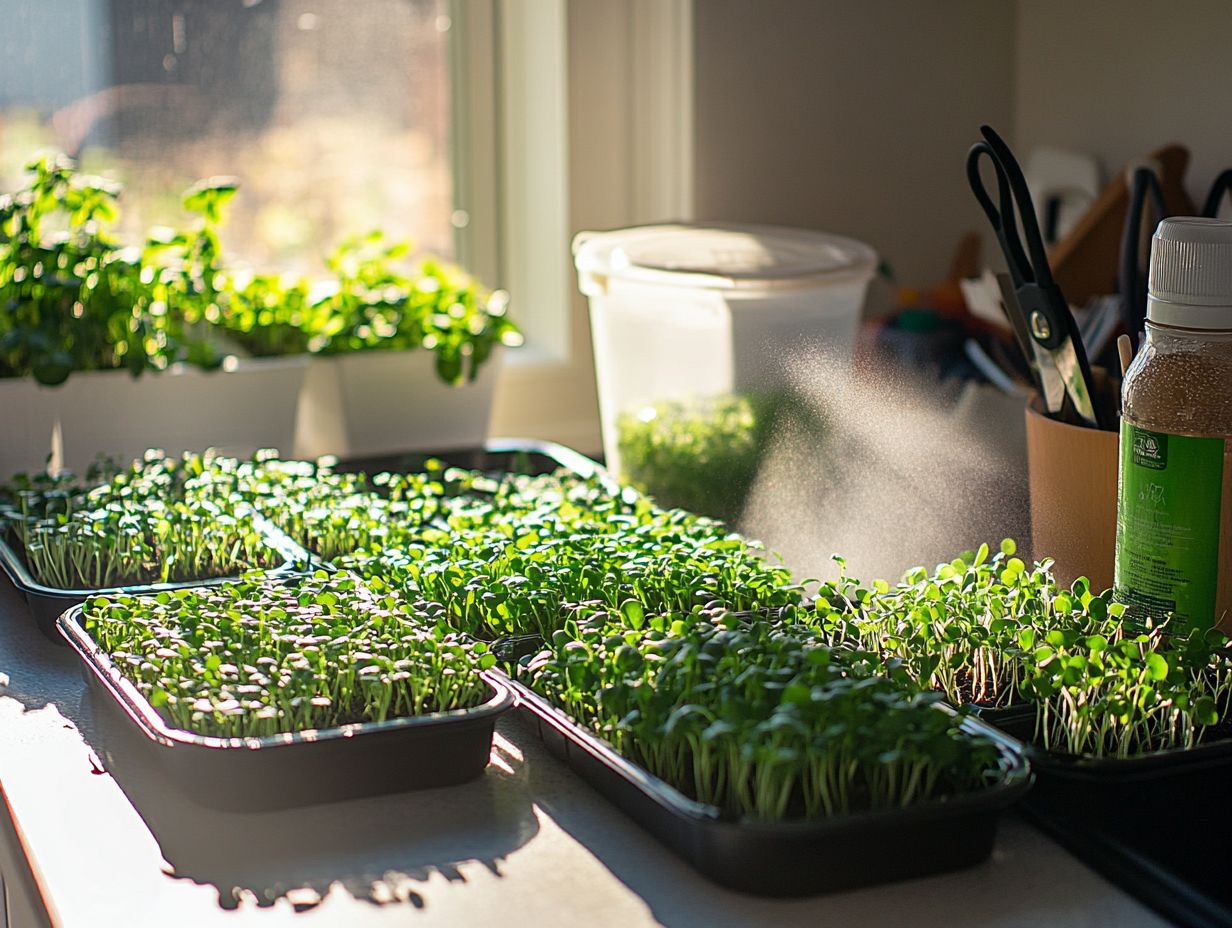
Using preservatives can be a savvy strategy to enhance the shelf life of your microgreens, allowing for optimal nutrient retention while keeping that all-important moisture balance intact.
You have many options: Natural preservatives like citric acid and vinegar stand out as popular choices, thanks to their substances that prevent the growth of germs that effectively combat spoilage.
Plant extracts such as rosemary and green tea are also gaining traction. They are celebrated for their ability to extend freshness without sacrificing flavor.
It’s important to consider the possible drawbacks. For instance, preservatives might alter the taste profile or how they feel and taste of your microgreens.
While chemical preservatives can be effective, they may stir up consumer concerns about safety and health. Striking the right balance between effectiveness and natural methods helps you keep your microgreens high-quality and appealing in a competitive market.
Frequently Asked Questions
Got questions about keeping your microgreens fresh? Here are the most common queries answered!
What is the best way to prevent spoilage in microgreens?
The best way to prevent spoilage in microgreens is to store them properly in a cool, dry environment and use them within a few days of purchasing or harvesting.
How can I tell if my microgreens are spoiled?
Signs of spoilage in microgreens include wilting, discoloration, and a slimy texture. They may also have a sour or unpleasant odor, indicating poor moisture balance.
Should I wash my microgreens before storing them?
It is not recommended to wash your microgreens before storing, as excess moisture can contribute to spoilage. It’s best to wash them just before consuming.
Can I freeze microgreens to prevent spoilage?
Yes, you can freeze microgreens to prevent spoilage, but this may affect their texture and flavor. It is best to use fresh microgreens for optimal taste and nutrition.
What are some common causes of spoilage in microgreens?
Some common causes of spoilage in microgreens include improper storage, excess moisture, and contamination from bacteria or mold. It is important to handle microgreens with clean hands and store them in a clean environment to prevent contamination.
Are there any natural methods to prevent spoilage in microgreens?
Yes, some natural methods to prevent spoilage in microgreens include using breathable storage containers, adding a paper towel to absorb excess moisture, and incorporating vinegar or lemon juice into the water used for watering the microgreens.
Try these tips today to enjoy fresh microgreens longer!

